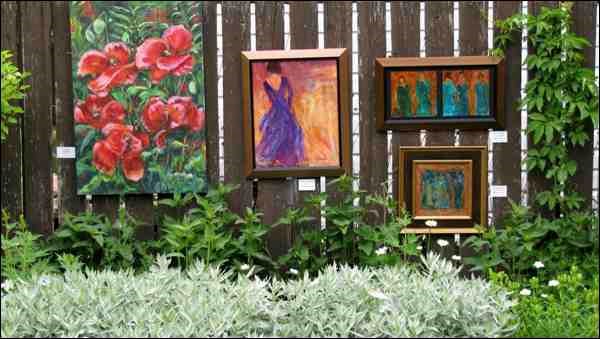Gardens and art have been closely tied together for centuries. And while it may be obvious to many that gardens can be a source of inspiration for an artist - beautiful flowers and fruits, spectacular or subtle colour combinations, large and grand vistas, studies of the interplay of light and shadow - art in the garden can be an important, if overlooked, element of design. So says Karen Maguire, one of a group of five artists who have been using gardens both as their muse and as a natural, outdoor art gallery to display their work.
Karen says art adds interest to a garden. As a focal point, art can be used to draw attention to a special planting and to draw visitors into a garden along a carefully planned path. It can also be used to add height and drama to a space. In addition, art can be used to create surprise when it is hidden out of sight, say around a corner.
Interestingly, you can reverse this idea of incorporating art into a garden. Instead, you can use carefully considered plantings to highlight a important or special pieces of art. This is the case in the Leo Mol Sculpture Garden in Assiniboine Park in Winnipeg or Frogner Park in Oslo, Norway where art is the focus and the plants are the accessories.
Sculpture is the medium that comes first to mind when one thinks of art in a garden, whether it is representational sculpture like a statue of a person or animal or more modern, abstract art. Depending on the materials used, sculptures can be relatively unchanging over time, aging little except for slight erosion or a build-up of a patina (e.g when made from metal or concrete) as a counterpoint to the constantly evolving garden. Or sculpture can be ephemeral in nature (e.g. if made from wood) changing dynamically and dramatically over time adding new layers of colour and texture as it visibly grows older and perhaps decays.
However, art in the garden doesn't have to be limited to three-dimensional art. Karen says she hangs paintings in her garden. You can hang art on your fence, a freestanding trellis, gazebo walls or a pergola. And why not? The paintings add colour, interest and draws the eye above the plant canopy. And like walls, fences and other vertical structures are ideal for hanging things on them, they are used to outline boundaries to define [garden] rooms, and they can create a sense of privacy or intimacy. And there's no need to limit it to paintings - photography works just as well. Karen brings her artwork in at night and advises to avoid exposing it to direct sun and to protect it from inclement weather.
Karen, with fellow painters Kathleen Slavin and Sylvia Thompson, sculptor James Korpan and photographer John Perret have been showcasing their artwork in various outdoor spaces for several years in Saskatoon. This year they will be hosting their ninth show and sale in Karen's garden at 16 Cambridge Crescent on Saturday, Aug. 16 (10 a.m. - 5 p.m.) and Sunday, Aug. 17 (noon - 5 p.m.). This event is free and open to the public. In addition to a showcase of their art in a garden setting, you will be treated to live entertainment (guitarist Evert Van Olst) and refreshments on Saturday.
Have a gardening question? Contact GardenLine, 306-966-5865 or [email protected]
- This column is provided courtesy of the Saskatchewan Perennial Society (www.saskperennial.ca; [email protected]). Check out our Bulletin Board or Calendar for upcoming horticulture events (Labour&Learn at the Forestry Farm; garden tours).




